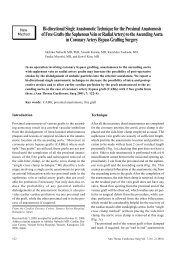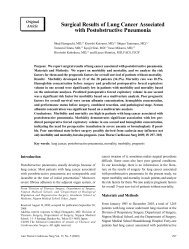Aortic Valve Replacement in a Patient with Alpha-Thalassemia
Aortic Valve Replacement in a Patient with Alpha-Thalassemia
Aortic Valve Replacement in a Patient with Alpha-Thalassemia
You also want an ePaper? Increase the reach of your titles
YUMPU automatically turns print PDFs into web optimized ePapers that Google loves.
Case<br />
Report<br />
<strong>Aortic</strong> <strong>Valve</strong> <strong>Replacement</strong> <strong>in</strong> a <strong>Patient</strong> <strong>with</strong><br />
<strong>Alpha</strong>-<strong>Thalassemia</strong><br />
Tadashi Omoto, MD, 1 Takeo Tedoriya, MD, 1 Yasuyuki Kondo, MD, 1 Hirofumi Izuka, MD, 1<br />
Masaya Oi, MD, 1 Naoko Nagano, MD, 1 Tadamasa Miyauchi, MD, 1 Noboru Ishikawa, MD, 1<br />
and Hitoshi Kasegawa, MD 2<br />
Cardiac valve disease result<strong>in</strong>g from elastic tissue defects has been demonstrated <strong>in</strong> patients<br />
<strong>with</strong> beta-thalassemia; however, valve disorders of patients <strong>with</strong> alpha-thalassemia have been<br />
rarely discussed. We present the case of a patient <strong>with</strong> alpha-thalassemia and severe aortic<br />
regurgitation <strong>with</strong> left ventricular dysfunction. The patient underwent successful aortic valve<br />
replacement <strong>with</strong> mechanical prosthesis. Histopathology of the excised valve showed elastic<br />
tissue disruption and chronic thrombus on the ventricular side. Hypercoagulative states have<br />
been observed <strong>in</strong> patients <strong>with</strong> alpha-thalassemia as beta-thalassemia; therefore special<br />
attention should be taken <strong>in</strong> perioperative anticoagulation therapy. (Ann Thorac Cardiovasc<br />
Surg 2010; 16: 365–366)<br />
Key words: anemia, valve, coagulation<br />
Introduction<br />
Cardiac valve disease as a result of elastic tissue defects<br />
is known <strong>in</strong> patients <strong>with</strong> beta-thalassemia. We present<br />
the case of a patient <strong>with</strong> alpha-thalassemia-1 and severe<br />
aortic regurgitation who underwent successful aortic<br />
valve replacement.<br />
Cl<strong>in</strong>ical Summary<br />
A 36-year-old man was referred to our hospital <strong>with</strong><br />
severe aortic valve <strong>in</strong>sufficiency. He had no major medical<br />
or family history. Anemia has never been po<strong>in</strong>ted out<br />
previously. Preoperative hemoglob<strong>in</strong> and serum ferrit<strong>in</strong> levels<br />
From 1 Department of Surgery, Division of Thoracic and<br />
Cardiovascular Surgery Showa University, Tokyo; 2 Hanzomon<br />
Cardiovascular Cl<strong>in</strong>ice, Tokyo, Japan<br />
Received May 26, 2009; accepted for publication August 25, 2009<br />
Address repr<strong>in</strong>t requests to Tadashi Omoto, MD: Department of<br />
Surgery, Division of Thoracic and Cardiovascular Surgery, Showa<br />
University, Tokyo, Hatanodai 1–5–8, Sh<strong>in</strong>agawa-ku, Tokyo 142–<br />
8666, Japan.<br />
©2010 The Editorial Committee of Annals of Thoracic and<br />
Cardiovascular Surgery. All rights reserved.<br />
were 9.4 g/dl and 500 ng/ml, respectively. Reticulocytes<br />
comprised 1.9%. Polymerase cha<strong>in</strong> reaction analysis<br />
revealed double alpha-glob<strong>in</strong> gene deletion, and he was<br />
diagnosed as alpha-thalassemia-1 (abbreviated -, -, Southeast<br />
Asian [SEA] type). Echocardiography showed severe aortic<br />
regurgitation <strong>with</strong> left ventricular (LV) dysfunction (ejection<br />
fraction 35%) and LV dilatation (end-diastolic/endsystolic<br />
diameter 93/76 mm). Computed tomography (CT)<br />
showed calcification of the ascend<strong>in</strong>g aorta and abdom<strong>in</strong>al<br />
aorta. <strong>Aortic</strong> valve replacement was recommended; it was<br />
tricuspid <strong>with</strong> a prolapsed left cusp. So the aortic valve was<br />
removed, and replacement was made us<strong>in</strong>g an On-X bileaflet<br />
mechanical valve (25 mm; Medical Carbon Research<br />
Institute LLC, Aust<strong>in</strong>, Texas). In the operat<strong>in</strong>g room, the<br />
patient required red blood cell transfusions. Postoperative<br />
values of hemoglob<strong>in</strong> and hematocrit were 9.9 mg/dl and<br />
30.6%, respectively. Dur<strong>in</strong>g microscopic exam<strong>in</strong>ation, a<br />
disruption of collagen fibers <strong>in</strong> pars fibrosa and of acid<br />
mucopolysaccharide <strong>in</strong>filtration, <strong>with</strong>out <strong>in</strong>flammatory<br />
cell <strong>in</strong>filtration, were observed (Fig. 1). Furthermore, chronic<br />
thrombosis was found on the ventricular side of aortic valve<br />
cusps, which suggested the hypercoagulative state of this<br />
patient. The postoperative course was uneventful, and the<br />
patient is do<strong>in</strong>g well at six months of follow-up.<br />
Ann Thorac Cardiovasc Surg Vol. 16, No. 5 (2010)<br />
365
Omoto et al.<br />
Discussion<br />
<strong>Alpha</strong>-thalassemia is an <strong>in</strong>herited hemoglob<strong>in</strong> disorder<br />
caused by impaired synthesis of the alpha-glob<strong>in</strong> cha<strong>in</strong>. 1)<br />
Two phenotypes have been def<strong>in</strong>ed: <strong>Alpha</strong>-thalassemia-1<br />
is associated <strong>with</strong> a complete absence of alpha-glob<strong>in</strong><br />
synthesis, and alpha-thalassemia-2 <strong>with</strong> only a reduction.<br />
The alpha-thalassemia-1 phenotype is caused by several<br />
deletions affect<strong>in</strong>g both alpha-glob<strong>in</strong> genes, and the deletion<br />
of ‒-, ‒-, SEA extends from the 3’ end of the ζ-gene<br />
through the alpha-1-glob<strong>in</strong> gene. 1) In patients <strong>with</strong> alphathalassemia-1,<br />
alpha cha<strong>in</strong> synthesis is impaired, but<br />
balanced; anemia is relatively mild, and hemolytic and<br />
proliferative features of thalassemia major are not<br />
observed.<br />
Studies of patients <strong>with</strong> beta-thalassemia 2) have revealed<br />
the follow<strong>in</strong>g.<br />
(1) LV dysfunction <strong>in</strong>duced by chronic iron overload is<br />
the most common cause of death <strong>in</strong> patients <strong>with</strong> thalassemia<br />
major. (2) The multiple-organ effects of chronic<br />
anemia and tissue hypoxia, along <strong>with</strong> associated compensatory<br />
reactions that <strong>in</strong>clude enhanced erythropoiesis<br />
and <strong>in</strong>creased iron absorption, appear <strong>in</strong> thalassemia<br />
<strong>in</strong>termedia. (3) <strong>Valve</strong> leaflet thicken<strong>in</strong>g, valve stenosis,<br />
and regurgitation appear <strong>in</strong> patients <strong>with</strong> thalassemia.<br />
The pathogenesis of cardiac valve disease <strong>in</strong> patients<br />
<strong>with</strong> thalassemia is associated <strong>with</strong> elastic tissue disruption.<br />
2) The strong oxidative stress caused by accumulated<br />
and prolonged effects of chronic hemolysis may be<br />
responsible for elast<strong>in</strong> metabolism and structural properties.<br />
2) In the case we present, there is a significant<br />
disruption of collagen fibers <strong>in</strong> pars fibrosa and chronic<br />
thrombosis on the ventricular side <strong>in</strong> valve histology, which<br />
suggests a hyper coagulative state <strong>in</strong> this patient (Fig. 1).<br />
Few reports have described patients <strong>with</strong> beta-thalassemia<br />
who have undergone cardiac valve operations;<br />
however, their hypercoagulative states may be associated<br />
<strong>with</strong> perioperative thrombotic complications. Farmakis et<br />
al. 3) reported their experience of aortic valve replacement<br />
<strong>in</strong> a patient <strong>with</strong> beta-thalassemia <strong>in</strong>termedia. The patient<br />
underwent a successful valve replacement by mechanical<br />
prosthesis, but rapid thrombosis occurred 16 months after<br />
the operation despite proper antithrombotic therapy. Successful<br />
mitral valve replacement by mechanical<br />
prosthesis <strong>in</strong> a patient <strong>with</strong> beta-thalassemia major has<br />
also been reported. 4) In the present case, we chose a<br />
mechanical prosthesis based on the assumption that the<br />
age of the patient would compromise the longevity of a<br />
biological valve. <strong>Patient</strong>s <strong>with</strong> thalassemia reportedly<br />
Fig. 1. Histopathology shows a disruption of collagen fibers <strong>in</strong><br />
pars fibrosa and chronic thrombosis on the ventricular side.<br />
LV, left ventricle; Ao, aorta<br />
carry a risk of thrombosis of the valve prosthesis despite<br />
a standard warfar<strong>in</strong>-based anticoagulation therapy. This<br />
risk is believed to be of multifactorial orig<strong>in</strong>, and an<br />
important role may be played by a hypercoagulable state<br />
caused by thrombocytosis, defective erythrocyte and platelet<br />
membrane phospholipids, <strong>in</strong>creased blood levels of activation<br />
peptides, and decreased levels of antithrombotic<br />
prote<strong>in</strong>s. 5)<br />
In conclusion, prosthetic valve replacement has a risk<br />
of thrombotic complication <strong>in</strong> patients <strong>with</strong> thalasemia.<br />
Although patients <strong>with</strong> alpha-thalasemia have mild<br />
hematological features, the hypercoagulative state should<br />
be taken <strong>in</strong>to consideration for perioperative management.<br />
References<br />
1. Lukens JN. The thalassemias and related disorders. In:<br />
Lee RG, Foerster J, eds. W<strong>in</strong>trobe’s Cl<strong>in</strong>ical Hematology.<br />
10th ed. Baltimore, Maryland: Williams & Wilk<strong>in</strong>s;<br />
1999: 1407–9.<br />
2. Aessopos A, Farmakis D, Karagiorga M, Voskaridou E,<br />
Loutradi A, et al. Cardiac <strong>in</strong>volvement <strong>in</strong> thalassemia<br />
<strong>in</strong>termedia: a multicenter study. Blood 2001; 97: 3411–6.<br />
3. Farmakis D, Polonifi A, Deftereos S, Tsironi M, Papaioannou<br />
I, et al. <strong>Aortic</strong> valve replacement <strong>in</strong> a patient <strong>with</strong><br />
thalassemia <strong>in</strong>termedia. Ann Thorac Surg 2006; 81: 737–9.<br />
4. Botta L, Sav<strong>in</strong>i C, Mart<strong>in</strong>-Suarez S, Dell’ Amore A,<br />
Camurri N, et al. Successful mitral valve replacement<br />
<strong>in</strong> a patient <strong>with</strong> a severe form of beta-thalassaemia.<br />
Heart, Lung and Circ 2008; 17: 62–79.<br />
5. Schrier SL, Angelucci E. New strategies <strong>in</strong> the treatment<br />
of the thalassaemias. Ann Rev Med 2005; 56: 157–71.<br />
366<br />
Ann Thorac Cardiovasc Surg Vol. 16, No. 5 (2010)








